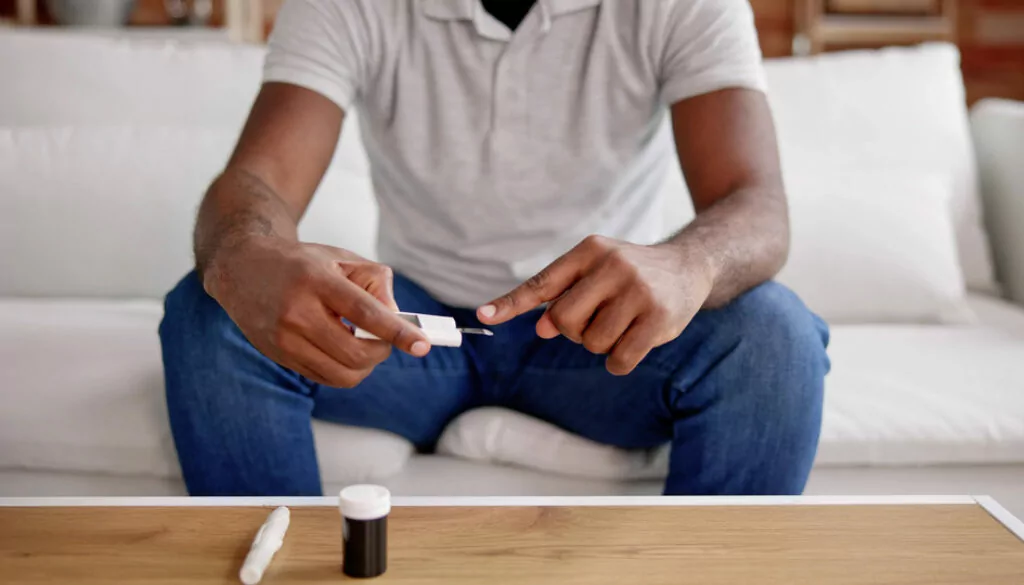Welcome to our comprehensive guide on hyperglycemia, a condition characterized by elevated levels of glucose (sugar) in the blood. This condition is often associated with diabetes but can affect individuals without diabetes as well. Managing hyperglycemia is crucial for maintaining overall health and preventing long-term complications. In this blog, we’ll explore the various hyperglycemia treatment options.
Contents
What Are 5 Signs Of a Diabetic Emergency?
 A diabetic emergency can occur when blood sugar levels become dangerously high (hyperglycemia) or dangerously low (hypoglycemia). Recognizing the signs of a diabetic emergency is crucial for timely and effective intervention. Here are five signs that may indicate a diabetic emergency:
A diabetic emergency can occur when blood sugar levels become dangerously high (hyperglycemia) or dangerously low (hypoglycemia). Recognizing the signs of a diabetic emergency is crucial for timely and effective intervention. Here are five signs that may indicate a diabetic emergency:
- Extreme Weakness or Dizziness: This can be a sign of both hyperglycemia and hypoglycemia. The body’s inability to properly use glucose for energy can lead to feelings of exhaustion, weakness, or dizziness.
- Altered Mental Status: This includes confusion, disorientation, or difficulty in thinking clearly and can be a symptom of severe hypoglycemia. In cases of hyperglycemia, a person might also exhibit unusual behavior, irritability, or agitation.
- Rapid Heartbeat and Shaking: A rapid or irregular heartbeat, often accompanied by trembling or shaking, is a common sign of hypoglycemia. This is due to the body’s release of adrenaline in response to low blood sugar levels.
- Severe Headache or Vision Problems: High blood sugar levels can lead to headaches and vision issues like blurriness or double vision. These symptoms should not be ignored as they can indicate that the blood sugar level is dangerously high.
- Loss of Consciousness or Seizure: In severe cases, a diabetic emergency can lead to unconsciousness or seizures. This is most often associated with hypoglycemia. But can also occur in extreme cases of hyperglycemia.
It’s important to note that these symptoms require immediate medical attention. If you or someone else is experiencing these signs, seek emergency medical help right away. Managing diabetes effectively and regular monitoring of blood sugar levels are key to preventing such emergencies.
What Are The Best Hyperglycemia Treatment Options?
Treating hyperglycemia, or high blood sugar, involves a combination of lifestyle changes, self-monitoring, and possibly medication. The best treatment options often depend on the underlying cause of hyperglycemia, such as diabetes type 1 or 2, and individual health factors. Here are some of the most effective hyperglycemia treatment options:
Medication Management
Medication plays a vital role in the treatment of hyperglycemia, especially for those with diabetes. In Type 1 diabetes, the body doesn’t produce insulin. So insulin therapy is essential. This involves taking insulin injections multiple times a day or using an insulin pump that provides a steady supply. For Type 2 diabetes, oral medications like metformin are commonly prescribed. Metformin helps to reduce glucose production in the liver and improve insulin sensitivity. For some individuals, especially as Type 2 diabetes progresses, insulin or other injectables like GLP-1 receptor agonists may be required.
Dietary Changes
A key component in managing hyperglycemia is dietary modification. Carbohydrate counting is crucial, as carbohydrates directly impact blood sugar levels. It involves keeping track of the amount of carbohydrates consumed at each meal and adjusting insulin accordingly. Adopting a balanced diet is equally important. A diet rich in fruits, vegetables, whole grains, and lean proteins, with limited intake of processed foods, refined sugars, and saturated fats, can help maintain stable blood sugar levels.
Regular Physical Activity
 Physical activity is beneficial for blood sugar control as it increases insulin sensitivity, meaning your cells are better able to use the available sugar in your bloodstream. Regular exercise such as brisk walking, cycling, swimming, or any other aerobic activity for at least 150 minutes per week is recommended. It’s important to spread this activity throughout the week and not just on one or two days. For those taking insulin or insulin-stimulating medications, monitoring blood sugar levels before and after exercise is important to prevent hypoglycemia (low blood sugar).
Physical activity is beneficial for blood sugar control as it increases insulin sensitivity, meaning your cells are better able to use the available sugar in your bloodstream. Regular exercise such as brisk walking, cycling, swimming, or any other aerobic activity for at least 150 minutes per week is recommended. It’s important to spread this activity throughout the week and not just on one or two days. For those taking insulin or insulin-stimulating medications, monitoring blood sugar levels before and after exercise is important to prevent hypoglycemia (low blood sugar).
Blood Sugar Monitoring
Regularly checking blood sugar levels is crucial in managing hyperglycemia. This can be done using a traditional blood glucose meter, which involves pricking the finger to get a blood sample, or through continuous glucose monitoring systems (CGMs) that provide real-time blood sugar readings. Monitoring helps in making informed decisions about diet, exercise, and medication. It also helps in identifying patterns and trends in blood sugar levels. This is vital for long-term diabetes management.
Weight Management
For those with Type 2 diabetes or at risk of developing it, maintaining a healthy weight can significantly improve the body’s ability to regulate blood sugar and respond to insulin. Even a modest weight loss of 5-10% can have a considerable impact on blood sugar control. This can be achieved through a combination of dietary changes, increased physical activity, and behavioral strategies. It’s important to approach weight loss sustainably and healthily, focusing on gradual changes rather than rapid weight reduction.
Stress Management
Stress has a significant impact on blood sugar levels. When stressed, the body releases hormones like cortisol and adrenaline, which can cause blood sugar levels to rise. This is especially problematic in individuals with diabetes who may already have difficulty regulating their blood sugar levels. Effective stress management strategies are therefore an important aspect of hyperglycemia treatment. Techniques such as mindfulness, meditation, yoga, and deep breathing exercises can help reduce stress. Regular participation in enjoyable activities and hobbies, as well as seeking support from friends, family, or professional counselors, can also be beneficial.
Hydration
 Proper hydration is crucial for maintaining health, and it plays a specific role in managing hyperglycemia. When blood sugar levels are high, the body tries to excrete excess glucose through urine, which can lead to dehydration. Drinking adequate water can aid in this process and help lower blood sugar levels. It’s recommended to drink water or other non-caloric beverages and avoid sugary drinks, which can worsen hyperglycemia. Monitoring fluid intake is particularly important during hot weather or when exercising, as these conditions can increase the risk of dehydration.
Proper hydration is crucial for maintaining health, and it plays a specific role in managing hyperglycemia. When blood sugar levels are high, the body tries to excrete excess glucose through urine, which can lead to dehydration. Drinking adequate water can aid in this process and help lower blood sugar levels. It’s recommended to drink water or other non-caloric beverages and avoid sugary drinks, which can worsen hyperglycemia. Monitoring fluid intake is particularly important during hot weather or when exercising, as these conditions can increase the risk of dehydration.
Regular Health Check-ups
Regular visits to a healthcare provider are essential for anyone managing hyperglycemia, especially for those with diabetes. These check-ups should include not only blood sugar monitoring but also screening for complications of diabetes such as neuropathy, nephropathy, retinopathy, and cardiovascular issues. Health professionals can adjust medications, recommend lifestyle changes, and provide guidance on new treatments or management strategies. These visits are also an opportunity to discuss any challenges or concerns regarding diabetes management.
Education and Support
Knowledge is power when it comes to managing hyperglycemia. Understanding the condition, its risks, treatment options, and lifestyle modifications is crucial. This can be achieved through diabetes education programs. These are often available at hospitals or community centers. These programs can provide valuable information on nutrition, exercise, medication management, and monitoring blood sugar levels. Support from healthcare providers, as well as from peers who are also managing diabetes, can be incredibly helpful.
Overall, managing hyperglycemia treatment effectively involves a holistic approach that includes not just medical treatments but also lifestyle modifications, regular monitoring, and education.
What IV Fluids Are Used For Hyperglycemia?
 Intravenous (IV) fluids play a crucial role in the treatment of severe hyperglycemia, especially in emergencies like diabetic ketoacidosis (DKA) or hyperosmolar hyperglycemic state (HHS). These are serious complications of diabetes. The type of IV fluids used depends on the patient’s hydration status, electrolyte levels, and the severity of hyperglycemia. Here are the common types of IV fluids used:
Intravenous (IV) fluids play a crucial role in the treatment of severe hyperglycemia, especially in emergencies like diabetic ketoacidosis (DKA) or hyperosmolar hyperglycemic state (HHS). These are serious complications of diabetes. The type of IV fluids used depends on the patient’s hydration status, electrolyte levels, and the severity of hyperglycemia. Here are the common types of IV fluids used:
Normal Saline (0.9% Sodium Chloride)
This is often the first choice in the treatment of severe hyperglycemia, particularly in emergencies. Normal saline helps to restore fluid balance in the body and correct dehydration that often accompanies high blood sugar levels. It’s isotonic, meaning it has a similar concentration of salt and water as in the blood. Ultimately, making it safe for initial rehydration.
Half-Normal Saline (0.45% Sodium Chloride)
After initial rehydration with normal saline, half-normal saline may be used, especially if blood sodium levels are high or normal. It has a lower concentration of sodium and chloride compared to normal saline. And, making it a good choice for continued hydration once the immediate deficit has been addressed.
Dextrose Solutions
Once blood sugar levels start to decrease (usually below 250 mg/dL in DKA or below 300 mg/dL in HHS), dextrose is often added to the IV fluids. This prevents the blood sugar from dropping too low (hypoglycemia) and provides the body with a source of energy, as insulin therapy continues to be administered. The concentration of dextrose (e.g., 5% or 10%) depends on the patient’s current blood sugar levels and ongoing needs.
Potassium Supplementation
Potassium is often added to IV fluids, as insulin therapy and increased urination can lead to a significant decrease in potassium levels. Monitoring and maintaining the right potassium level is essential. Both high and low potassium levels can be dangerous.
It’s important to note that the administration of IV fluids in hyperglycemia, particularly in the context of diabetic emergencies, should be carefully monitored by healthcare professionals. They will assess the patient’s fluid needs, electrolyte levels, and overall health status to determine the most appropriate type and rate of fluid replacement.
Conclusion
In conclusion, hyperglycemia treatment involves a multifaceted approach. It’s crucial to regularly monitor blood sugar levels, adhere to prescribed medication, and maintain a balanced diet rich in nutrients while moderating carbohydrate intake. Regular physical activity plays a key role in enhancing insulin sensitivity and controlling blood sugar. Hydration, stress management, and regular health check-ups are equally important in preventing complications.
Remember, every small step towards a healthier lifestyle can have a significant impact on managing hyperglycemia. Do you want to get rid of diabetes? Join our online diabetes treatment program and reverse Diabetes naturally through lifestyle changes such as a Personalized Diet plan, Exercise, Yoga, dieticians, and health coaches.

